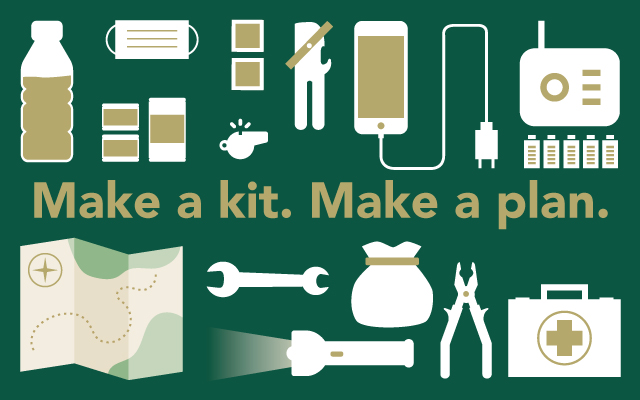Emergency Supply Kit
In a disaster, you may need to survive on your own for up to three days before emergency services can assist you. This means having your own food, water, and other supplies for you and your family for at least three days. Although emergency responders and local relief agencies will be working hard on scene following a disaster, they may be greatly overwhelmed. Depending on the severity and spread of the disaster, help could arrive within minutes, hours, or days.
Basic services such as electricity, gas, water, sewage treatment, and telephones may be cut off. You may become stranded away from your home, have to evacuate at a moment’s notice, or have to shelter in place. You probably will not have the time or ability to shop for the supplies you need to keep you and your family safe and healthy, so your supplies kit should contain items to help you manage during any of these outages.
Preparing a disaster supplies kit before a disaster strikes allows you peace of mind and the supplies you need to get through the first few days.
Since you do not know where you will be when an emergency occurs, prepare supplies for home, work and vehicles.
Water
- You need to store at least one gallon of water per person per day.
- When determining water quantities, also take into consideration:
- For hot climates, you may need to increase your water quantities
- Medical emergencies might require additional water
- Family pets will also require water
Food
- Gather foods that do not require refrigeration, cooking or special preparation.
- If you store canned foods, make sure to include a can opener.
- Make sure to include foods for family members with special dietary needs.
- If you have a pet, make sure to include pet food.
The Basics of Your Disaster Supply Kit
- Three-day supply of nonperishable food.
- Three-day supply of water - one gallon of water per person, per day.
- Portable, battery powered radio or television and extra batteries.
- Flashlight and extra batteries.
- First aid kit.
- Sanitation and hygiene items (moist towelettes and toilet paper).
- Matches and waterproof container.
- Whistle.
- Extra clothing.
- Kitchen accessories and cooking utensils, including a can opener.
- Photocopies of credit, identification cards, insurance paperwork and other important documents.
- Cash and coins.
- Food, water, and medicine for your pet.
- Special needs items; prescription medications, eye glasses, contact lens, hearing aid batteries.
- Items for infants, such as formula, diapers, bottles and pacifiers.
- Other items to meet your unique family needs.
Training and Maintenance
- Show your family members where the kit is located and how to use its components.
- Change out stored food and water every six months. Pay attention to expiration dates.
- Reevaluate your disaster supply kit at least once a year. Do you or your family have new prescriptions, paperwork, or any other new unique needs?
- For more information on creating an emergency kit, check out: https://www.ready.gov/build-a-kit



